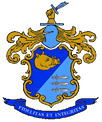

Department of History, Philosophy, Religion, and Social Sciences
Choate Rosemary Hall
Wallingford, Connecticut
History 415AD
AMERICAN POLITICAL INSTITUTIONS
Fall 2004 term
Hypertext Course Syllabus
| TABLE OF CONTENTS Goals of the Course Course Policies and Grading Texts and Course Materials Key Dates Program and Workload Schedule of Meetings and Assignments |
Mr.
Ned Gallagher Memorial House #114, 697-2340 Johnson Athletic Center #105, 697-2418 preferred e-mail: |

"The greatest dangers to
liberty lurk in the insidious encroachment by men of zeal--
well meaning but without understanding."
- Justice Louis Brandeis
This course constitutes a thorough study of the institutions that comprise the United States government. We will analyze the creation and workings of the component branches of the federal government via two distinct academic disciplines: history and political science. At the completion of this course, students should understand the fundamental elements--both in theory and in practice--of the three branches of the federal government, and how each relates to the others, to the states, and to the people.
In addition there will be considerable instruction in the skills needed by all historians, political scientists, and indeed citizens: how to read, how to analyze, and how to express one's self. Specifically, we hope to develop the general intellectual skills of:
The course is designed with these aims in mind to be a coöperative learning experience in appreciating and understanding the rich tapestry of American political life. Needless to say, no such understanding can be taught by someone else; it can only be learned for oneself.
A summary of course policies and grading standards can be found online by clicking here.
This text for the course--available at the school bookstore--should be purchased by all students immediately:
You will need to read ample supplementary materials for the course, as well--most of it available online.
This course will be orthodox in its presentation: in general, you'll read something before each meeting, and in class we'll discuss what you've read--what I call "Socratic discussion." You'll be expected to write short yet demanding papers, take two period tests and a final examination, and participate regularly in class.
The few papers you write must follow the "empirical essay" format and use the APEC method of argument. If the syllabus doesn't say something to the contrary, then the paper is to be two pages long. That means one sheet written on both sides if you handwrite, or two fronts if you type or word process. If you use notes or bibliography, they may go on a separate sheet. In fact, you may always write as many pages as you want, but the first two will be read and graded.
There also will be a heavy premium on participation in the "Model Congress" segment of the course. You will be expected to play an active role in committee proceedings and in the general sessions. More on this later.
One integral element of the course will be the field trip to Washington, DC, in which participants in the course will have rare "up close and personal" contact with all three branches of our federal government. The dates of the trip will be announced soon.
As part of the Model Congress exercise, you need to plan your schedule early so that you can avoid conflicts with required commitments for this course. What follows are the key dates for the Model Congress:
And please note these other important dates in the 2004 presidential election campaign:
Schedule of Meetings and Assignments
What follows is what we'll try to cover during the term. It may be adjusted from time to time for any number of reasons. The homework for the next class is always the next assignment unless you are told differently. You'll find each entry on the schedule below contains some instructive questions and ideas you should consider in preparing for class; get into the habit reading the syllabus carefully each night as you begin your homework.
1. Introduction.
In class, we'll meet each other, discuss the expectations of the course, and distribute materials you'll need.
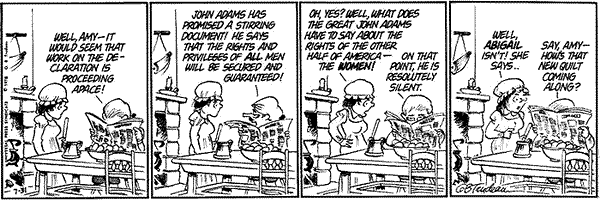
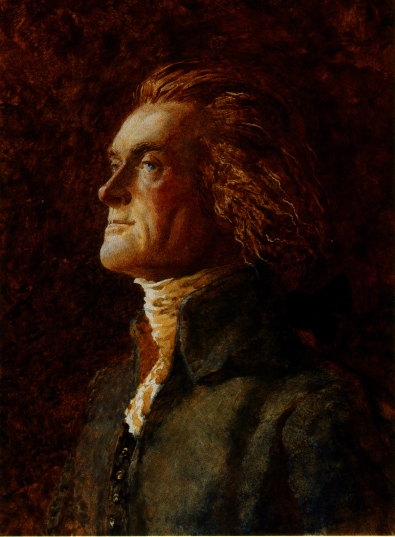 2.
We Hold These Truths To Be Self-Evident.
2.
We Hold These Truths To Be Self-Evident.
Read Wilson, pp. 3-16 and A1-A3 (The Declaration of Independence). Be sure you have a firm grasp of the dozen or so basic political terms defined in the Wilson reading. Also, read the Declaration carefully, even if you've read it before. You ought to be able to summarize the primary grievances the American colonists had in 1776. If you need help in approaching your reading assignments, there is some available online here.
3. Some Theory.
Read Wilson, pp. 19-32 and A4-A8 (Article I of The Constitution) and A26-A29 (Federalist #51). Be sure you understand the great dilemma before the state-makers in 1787: what were they trying to accomplish in "amending" the Articles of Confederation? Also, master the details concerning the 1787 convention, the Great Compromise, enumerated powers, and the hoped-for guarantees.
4. More Theory.
Read Wilson, pp. 32-41 and A8-A12 (Articles II-VII of The Constitution) and excerpt from John Locke's Second Treatise On Government. Some analysis of the powers of government, the powers of the other branches, and some limits. How does the Constitution reflect John Locke's vision of government? Ask for the rules for the upcoming "mass debate" on the Beard thesis in class #5.
5. The Beard Thesis.
Read Wilson, pp. 41-49 and A21-A25 (Federalist #10) and an excerpt from Charles Beard's anaylsis of the Constitution (distributed in photocopy form). Also skim Wilson, pp. A13-A20 (the Constitutional amendments) so that you are generally familiar with this material, which we'll talk about later. Every historian since 1913 who has written about the Constitution has had to deal with the Beard thesis. Some love it, some hate it; there seems to be little middle ground. Be able to state it concisely, and then be able to evaluate it and prepare to argue for or against it with your classmates. There will be a mass debate today.
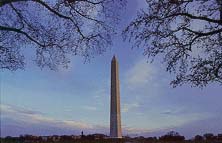
6. Federalism.
Read Wilson, pp. 51-68 and Federalist #39 and McCulloch v. Maryland. Here we see federalism, both as a theory and as a real-life controversy. What happened in the Bank case? Get the facts in the case and find out where in the Constitution the applicable sections are located. With whom would you have sided? Why? Period Test at #9. Look ahead.
7. The Public I.
Read Wilson, pp. 111-140. What are the most important influences on the way a person votes? On the way a person looks at issues? Do those influences affect you the way they affect most people? Prepare in writing a five-question poll of your classmates that you think will enable you to tell how they would vote.
8. The Public II.
Read Wilson, pp. 142-159. There are lots of terms that need to be defined here: liberal, conservative, civil rights, middle class, yuppie. What do they have to do with the branches of government as we've studied them and as you've seen them?
9. Period Test #1.
Covering all the material studied since the beginning of the term. There is advice online here about test-taking.
 10.
Congress I.
10.
Congress I.
Read Wilson, pp. 299-319; Federalist ##58, 62, and 63. How are Congressional Representatives elected? What determines who wins? What conflicts are inherent in what we want in a Representative? What did you learn about the committee system?
11. Congress II.
Read Wilson, pp. 319-343. How do the following things influence what happens in the Congress: party, interest groups, committee work, staffs? Note carefully the differences in the way the House and the Senate are organized, in the way the two work, and in who has power in each and why that person has that power. These are very important matters.
12. Congress III.
Read Wilson, pp. 343-360. Theoretically speaking, how do laws get passed? Refer to Article I, Section 7 if you need to. But how do laws get enacted in reality? What influences exactly what laws are adopted and what form they take? We may have an in-class essay on some topic involving possible reforms of Congress.
13. Political Parties I.
Read Wilson, pp. 163-178. Extra credit problem: bring to class a brief time-line, starting at 1787 and ending at 1990, that shows the development of the current party system. Do not try to do this project if you can't do it mainly from memory. How are the parties different today from what they were in 1861, in 1896, in 1912, in 1936? What's the New Deal Coalition? In class, we'll introduce the Model Congress.
14. Political Parties II.
Read Wilson, pp. 178-193. What is there about the parties that demonstrates what we've learned about separation of powers and federalism? What's good about our two-party system? What's bad?
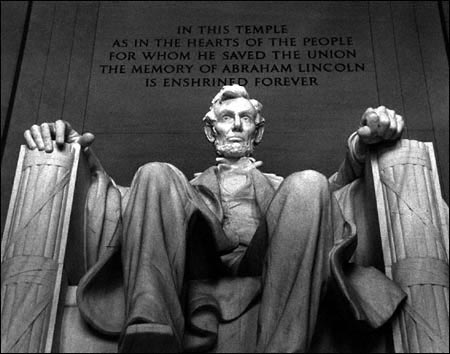 15. The
Presidency I.
15. The
Presidency I.
Read pp. Wilson, 363-376 and Federalist #70. Pay attention to the description of a prime minister; many people in the Vietnam/Watergate era thought that was a better system than ours. What are the powers of the President? How have they evolved from the statements in Article II, Sections 2a and 3?
16. The Presidency II.
Read pp. Wilson, 376-392. Is there a Democratic way of running the White House and a Republican way? Here is Garry Trudeau's take on one president's typical day. Where does the President get his power to make people do things? Be able to describe your answer by reference to an incident in your own life that your classmates may understand.
 17.
The Presidency III.
17.
The Presidency III.
Read pp. Wilson, 392-406 and U.S. v. Nixon decision. What powers does the President have that he can use against the other branches? How does he create his own program? In class, ask for instructions on how to do a "brief," and for the rules on the Mock Court cases, Brown v. Board, and Gideon v. Wainwright.
18. The Bureaucracy I.
Read Wilson, pp. 409-437. [first half] To what extent do the masses of unelected civil servants wield power? How do career public officials differ in their behavior from elected politicians? Is this good? Bad?
19. The Bureaucracy II.
Read Wilson, pp. 409-437. [second half] To what extent do the masses of unelected civil servants wield power? How do career public officials differ in their behavior from elected politicians? Is this good? Bad?
20. Period Test #2.
Covering all the material studied since the beginning of the term, but especially since the last period test. The test will then last 45 minutes.
21. Model Congress Preparation.
Read the instructions for the Model Congress carefully and prepare for a quiz on the rules and procedures.
22-24. Committee Sessions.
These three classes will be devoted to consideration of bills in committee. Robert's Rules of Order will be in effect. Details to come.
25. The Courts I.
Read Wilson, pp. 439-456 and Federalist #78. Read very carefully the sidebar about Marbury v. Madison on page 442 of the Wilson text. How is the federal court system organized? What duties does it have? Does it have any power of its own? If so, what and from where? If not, how does it get things done? Introduction to Model Congress in class.
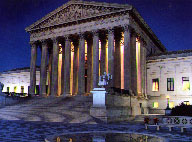 26.
The Courts II.
26.
The Courts II.
Read Wilson, pp. 456-469. What is the Supreme Court's jurisdiction? What's a "class action"? Note that this is a short assignment, so use the additional time to work in your assigned groups to prepare for the Brown v. Board of Education or Gideon v. Wainwright cases to be argued in #23 in Mock Court; details of this assignment and the Mock Court format may be found here.
27. The Courts III.
Read Wilson, pp. 473-496. What do these terms mean as applied to this assignment: applicablity, incorporation, distinguishing two cases, stare decisis?
28. The Courts IV: Mock Court.
We'll do the Mock Court cases in class today.
29. TBA.
30. Floor Session I (Evening Meeting).
Floor sessions in the evening in lieu of class. Evening Sessions on November 11, 14, 15, and 16. All sections of this course will meet in floor sessions of the entire House to consider the bills reported out by committee. Robert's Rules of Order will be in effect.
31. Floor Session II (Evening Meeting).
Floor sessions in the evening in lieu of class.
32. Floor Session III (Evening Meeting).
Floor sessions in the evening in lieu of class.
39. Wrap Up.
You will complete end-of-term evaluations in class, so think about any ideas you want to convey to your teacher about the class, the quality of instruction, and your own performance this term. Sadness will begin.
The course is ended; go in peace.
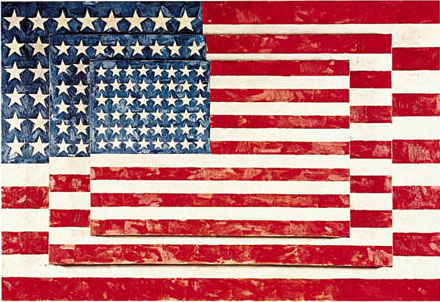
Jasper Johns, "Three Flags"
Syllabus
copyright © 1999-2004 Ned Gallagher. All rights reserved.
Last revised:
August 3, 2004